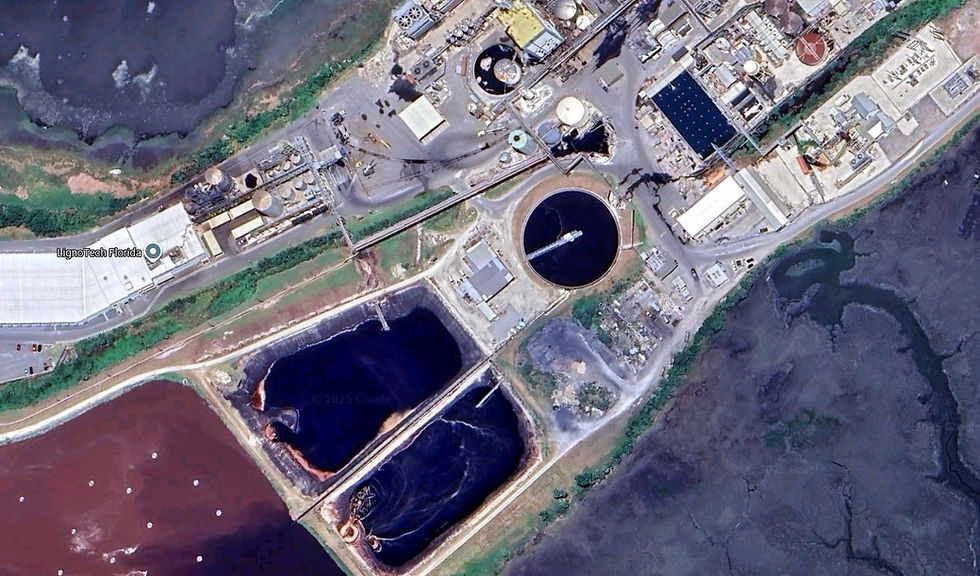Dissecting RYAM's ridiculous $6.6 million demand
- Mike Lednovich
- Sep 9, 2025
- 3 min read

RYAM’s demand for $6.6 million from Fernandina Beach is a classic case of trying to wrap a flawed argument in shiny packaging.
The claim that a land-locked 3-acre parcel on an industrial site that's likely polluted after 100 years of operation carried that value is on its face laughable. But nothing that RYAM does during this struggle over building a bioethanol production plant is surprising anymore.
Let's examine RYAM's claim and how it arrived at the $6.6 million valuation.
They're basing that number on a private appraisal that assumes the parcel inside the century-old pulp mill would have been worth over $7.1 million if only the bioethanol project had been greenlighted by the city.
That very assumption is the problem.
The appraisal by Haynes Valuation Services LLC of Clearwater is built on a hypothetical world in which the city had ignored its own Land Development Code prohibiting bioethanol production and storage, thus permitting RYAM to turn waste liquor into a lucrative new product line.
From there, the appraiser selected “before” comparables from fast-growing urban markets Miami, Palm Beach, and St. Augustine — where industrial land trades at $30 to $76 per square foot. Based on those values, Haynes said the RYAM site was priced at $55 per square foot —the equivalent of a prime South Florida waterfront lot.
That's pure rubbish: the subject property is not a vacant parcel on the Miami River or alongside I-95 in Palm Beach. It's 2.97 acres carved out of a pulp mill complex that has operated on Gum Street for nearly 100 years, surrounded by smokestacks, wastewater treatment, and heavy rail. Its marketability to anyone other than RYAM is close to zero.
That same Haynes appraisal tells a very different story when evaluating the land “after” the city’s denial. Using comparables in Duval and St. Johns counties, where industrial storage yards change hands at $3 to $7 per square foot, the appraiser values the site at roughly $500,000. That price tag is much more consistent with the reality of Northeast Florida’s industrial land market and with the physical context of the mill site.
But even that $500,000 figure may be overly optimistic. Why? The appraisal explicitly assumes the RYAM tract is free of environmental contamination. Yet this is a property embedded in a pulp mill complex that has produced sulfite-based cellulose for nearly a century, with byproducts that include acidic spent sulfite liquor and other industrial waste.
Across Florida and the U.S., legacy pulp and paper mills have been associated with hazardous substances in soil, groundwater, and nearby waterways. Any prospective buyer would in the normal due diligence demand environmental assessments, and the costs of remediation could erase much of the appraised value.
Just look at RYAM's shuttered cellulose facility in Port Angeles, Washington where the company has spent $30 million thus far in clean-up costs.
And the city holds a valuable trump card: brownfield designation authority.
Under Florida law, municipalities can designate properties as brownfields if there is actual or even perceived contamination. Such a designation doesn’t require evidence of pollution, only a reasonable belief based on the site's industrial history. A brownfield label would tie any redevelopment to cleanup requirements and immediately discount speculative land valuations like the $7 million RYAM claims. In practice, that would expose how unrealistic the appraisal’s assumptions really are.
In other words, the $6.6 million claim rests entirely on a fiction — that a Fernandina pulp mill outparcel should be valued like a prime redevelopment tract in Miami, and that it carries none of the environmental baggage typical of its history.
The Bert Harris Act requires governments to compensate landowners when regulations impose an “inordinate burden” on existing property rights. But compensation is supposed to reflect actual market loss, not speculative profit models, cherry-picked comparables from booming urban markets, or blind eyes to environmental risk.
The idea that the city should even think about yielding to this threat is absurd. RYAM would be dismissed in court for the reasons mentioned earlier.
The city needs to defend taxpayers vigorously against what looks less like a legitimate loss and more like an attempt to inflate value through creative appraisal gymnastics.




Comments